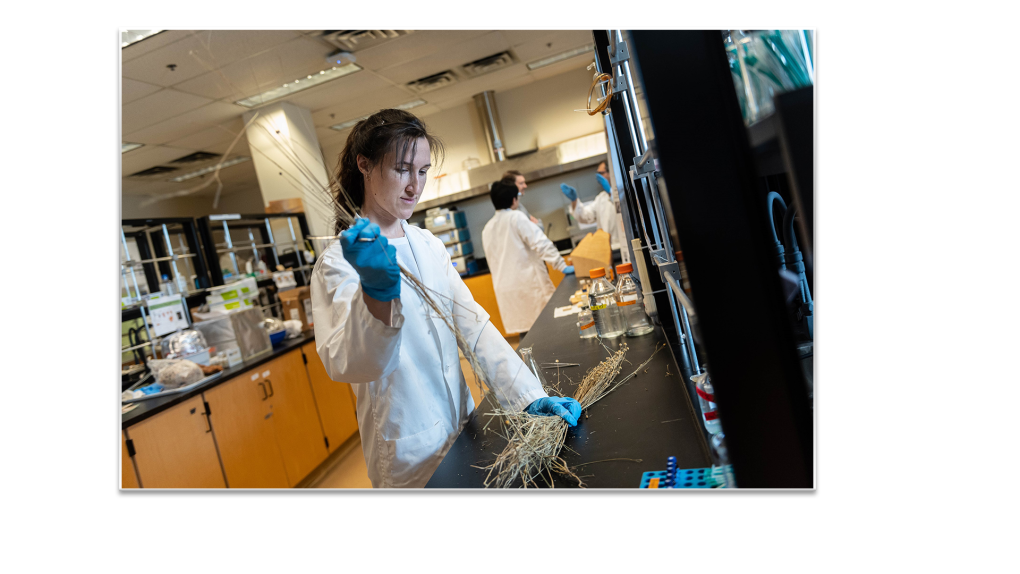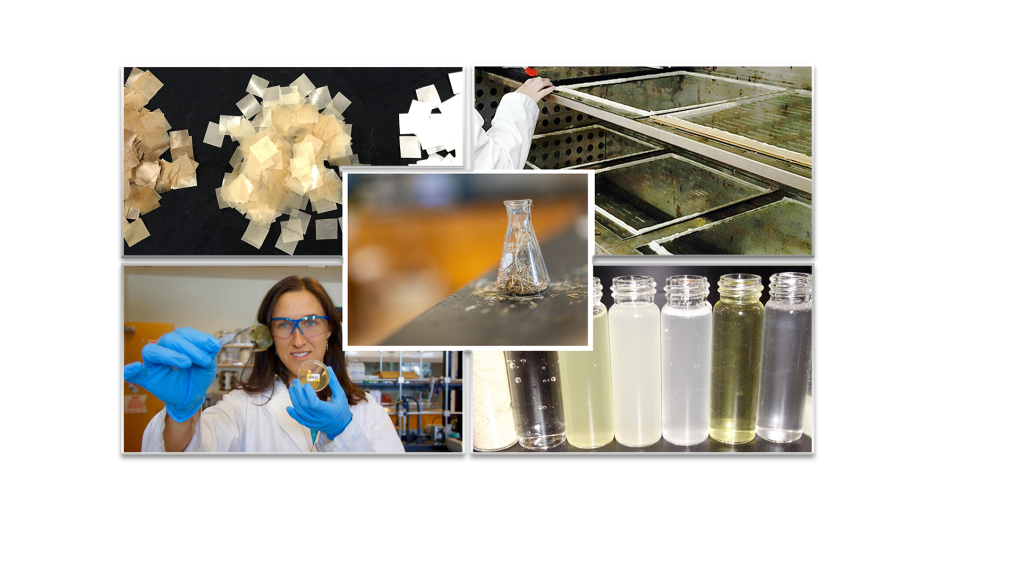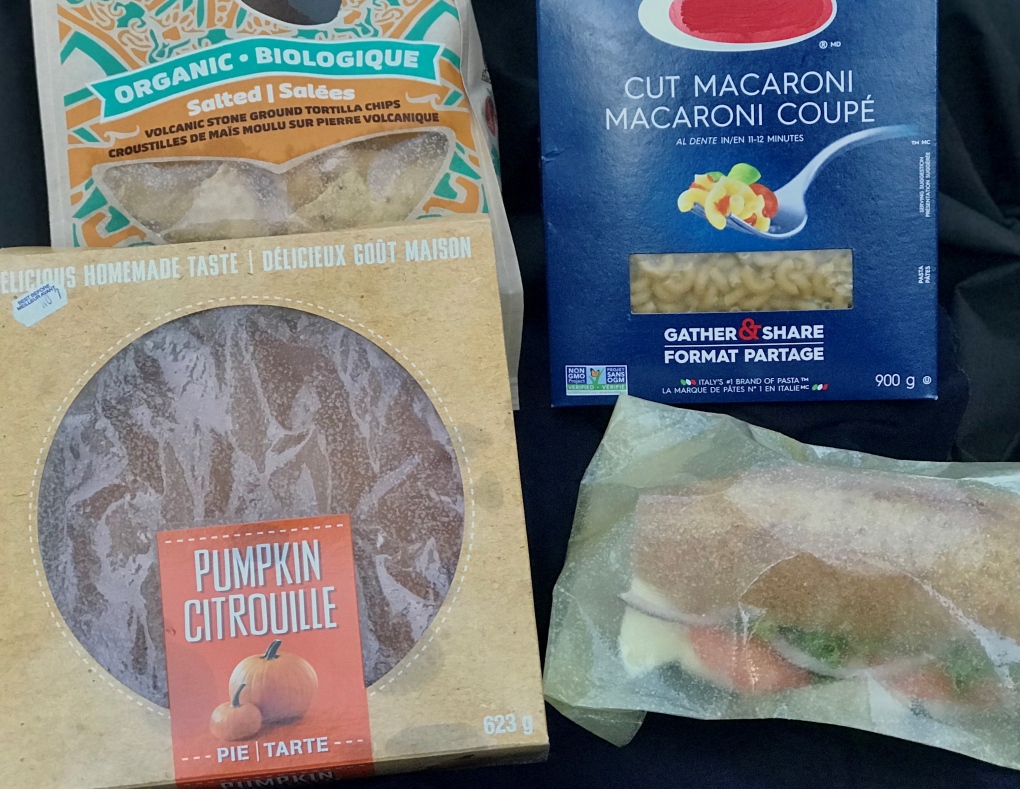Ottawa-born scientist on turning agricultural waste into plastic alternative called 'Grasstic'
Amanda Johnson is a nature-loving biochemist working to create a plastic alternative from crop leftovers.
"When you spend time in nature you develop a relationship and want to protect it," says Johnson, an eloquent and ardent PhD student in the Faculty of Forestry at the University of British Columbia.
Johnson, a lifelong camper, hiker, nature lover and mother of two young children, who grew up in Ottawa and studied biochemistry at the University of Ottawa, is researching turning agricultural waste into an alternative to plastic.
She calls the product she developed, "Grasstic" - a bioplastic made from the residual stalks of crops like corn or wheat.
"It’s abundant agricultural waste and currently no-one is doing anything with it other than bailing it off the field or sometimes tilling it in," explains Johnson.
"I thought I’m going to play around with this in the lab and I did."
Johnson says she tried different formulation processes.
"And it was pretty amazing because I actually held this plastic in my hand thinking it looks like plastic, it feels like plastic. I knew I was onto something."
 Ottawa-born, UBC PhD student in the Faculty of Forestry, Amanda Johnson, in the lab developing Grasstic. (Amanda Johnson and Daniela Camacho/submitted)
Ottawa-born, UBC PhD student in the Faculty of Forestry, Amanda Johnson, in the lab developing Grasstic. (Amanda Johnson and Daniela Camacho/submitted)
Johnson turned to her younger brother, David, for the name.
"He said, 'It’s made from grass, right?' I said, 'Yeah'. He said, 'call it Grasstic.'"
Grasstic stuck.
And 'fantastic' aspects of Grasstic were first learned when Johnson worked with grasses during her Masters.
"Grasses are made up of 20 per cent of the biopolymer called xylan and nothing is being done with it. It’s just a matter of getting it out of the plants and putting it into bioplastics," she says.
There are biodegradable plastic products out there but Johnson, committed to food sustainability, and conscious of food scarcity issues, wants to improve the options currently on the market.
"If you go to the store, you’ll be able to see biodegradable plastic bags that are made from plant polymers. The thing with these is that they’re made from corn, corn starch," says Johnson.
"When we start making packaging out of our food, we are going to run into problems with scarcity. We want to make them out of things that aren’t food."
The best uses for Grasstic, so far, are in packaging dry goods.
"Those films that you have on pastry products or dried goods boxes would be a perfect application for Grasstic."
Johnson demonstrates Grasstic being used to replace the plastic windows of pasta boxes and baked goods.
Those boxes then become totally biodegradable.
Johnson hosted a podcast about food, farming and sustainability and was motivated to get into the lab to create a new bioplastic when she learned the stats on plastics.
"Ninety per cent of the plastics we use, even the ones we put into the recycle bin, are never going to be recycled."
"They’re going to end up in an incinerator, or landfill, or worst-case scenario, contaminating our environment where they’ll stick around," says the research scientist.
Grasstic is now being tested for its rate of biodegradability.
"If you were to toss a Grasstic bag in your home compost, it would be completely gone in six weeks. If you sent it off to an industrial composting facility, it would be gone in four weeks," says the scientist.
"Currently, I'm testing how Grasstic biodegrades in the ocean. We are on day 95 of the experiment, and more than half of the Grasstic has biodegraded. So Grasstic is well on its way to being certified biodegradable.”
 Amanda Johnson, biochemist and UBC PhD student, using agricultural waste to create bioplastic, Grasstic. (Amanda Johnson and Daniela Camacho/submitted)
Amanda Johnson, biochemist and UBC PhD student, using agricultural waste to create bioplastic, Grasstic. (Amanda Johnson and Daniela Camacho/submitted)
Why we need plastic alternatives
"Nature has no way of breaking down plastic," Johnson says.
"Plastics break down into microscopic pieces called microplastics."
"Microplastics get into our water and our food. Scientists are only beginning to understand the problems they cause when ingested."
Plastics are made out of fossil fuels, which are a non-renewable resource.
"Huge amounts of plastic have accumulated in the ocean. Sea animals such as turtles and albatross mistake plastic for food and it kills them."
 Food wrapped in Grasstic, showing the potential 'future uses' of the bioplastic made from wheat and corn stalks, developed by UBC PhD student Amanda Johnson. Johnson is from Ottawa and did her degree in biochemistry at UofO. (Amanda Johnson/submitted)
Food wrapped in Grasstic, showing the potential 'future uses' of the bioplastic made from wheat and corn stalks, developed by UBC PhD student Amanda Johnson. Johnson is from Ottawa and did her degree in biochemistry at UofO. (Amanda Johnson/submitted)
That reality drives Johnson’s work. Her time in the lab for Johnson is fuelled by a lifetime spent outdoors.
"I’ve been close to nature my entire life. Growing up, my siblings and I spent countless hours playing in the forest behind our Ottawa home. My dad would take us biking along the Rideau Canal. My mom went camping with us."
And while Johnson, who now calls Victoria, B.C. home, reflects on that Ottawa past, she and her husband, Greg, are looking to create a promising future for their four-year-old, Millie and 15-month old Ori.
"Now that I'm a mom I want my kids to have the same chance to connect with nature. And that makes me passionate about preserving the environment."
CTVNews.ca Top Stories

Poilievre says Canadians 'fleeing' to Nicaragua, Liberals say it shows he 'doesn't have a clue'
Liberal parliamentarians are criticizing Conservative Leader Pierre Poilievre over a new video in which he promotes the idea that some Canadians are 'fleeing' Canada to live in Nicaragua because they can't afford a house in this country.
Canadians are eyeing moves to these cities for more affordable housing
Faced with elevated housing prices, half of Canadians in the country's largest cities are considering moving to places with more affordable housing.
Police clear intersection of pro-Palestinian protesters on UBC campus
Police have moved on pro-Palestinian protesters at the University of British Columbia campus in Vancouver, with video on social media showing lines of officers advancing on demonstrators rallying at a main intersection.
'Do not drive': Nissan warns Canadian drivers of explosion risk impacting 48,000 vehicles
Car manufacturer Nissan has issued a do-not-drive warning for some older vehicles equipped with Takata airbag inflators, due to the risk of explosion during a crash.
Infant dies in ATV crash, N.S. RCMP says alcohol may be a factor
An infant has died and three others, including another child, were taken to hospital following an ATV crash in Forties, N.S., on Monday.
'Scandals and secrets': On board the world's most exclusive private residential ship
It’s a floating city exclusively home to the 1 per cent, a playground for multimillionaires and billionaires that circumnavigates the world's oceans.
Tessa Virtue reveals she's expecting her first child. Here's what Canadians had to say
Canadian figure-skating icon Tessa Virtue is expecting her first child, she revealed via social media Tuesday.
New Orleans mystery: Human skull padlocked to a dumbbell is pulled out of water by a fisherman
New Orleans mystery: Human skull padlocked to a dumbbell is pulled out of water by a fisherman
Indian capital swelters as temperature hits all-time high of 52.9 C
Delhi recorded an all-time high temperature of 52.9 C (127.22 F) on Wednesday as extreme heat conditions gripped the north and western parts of India.


































